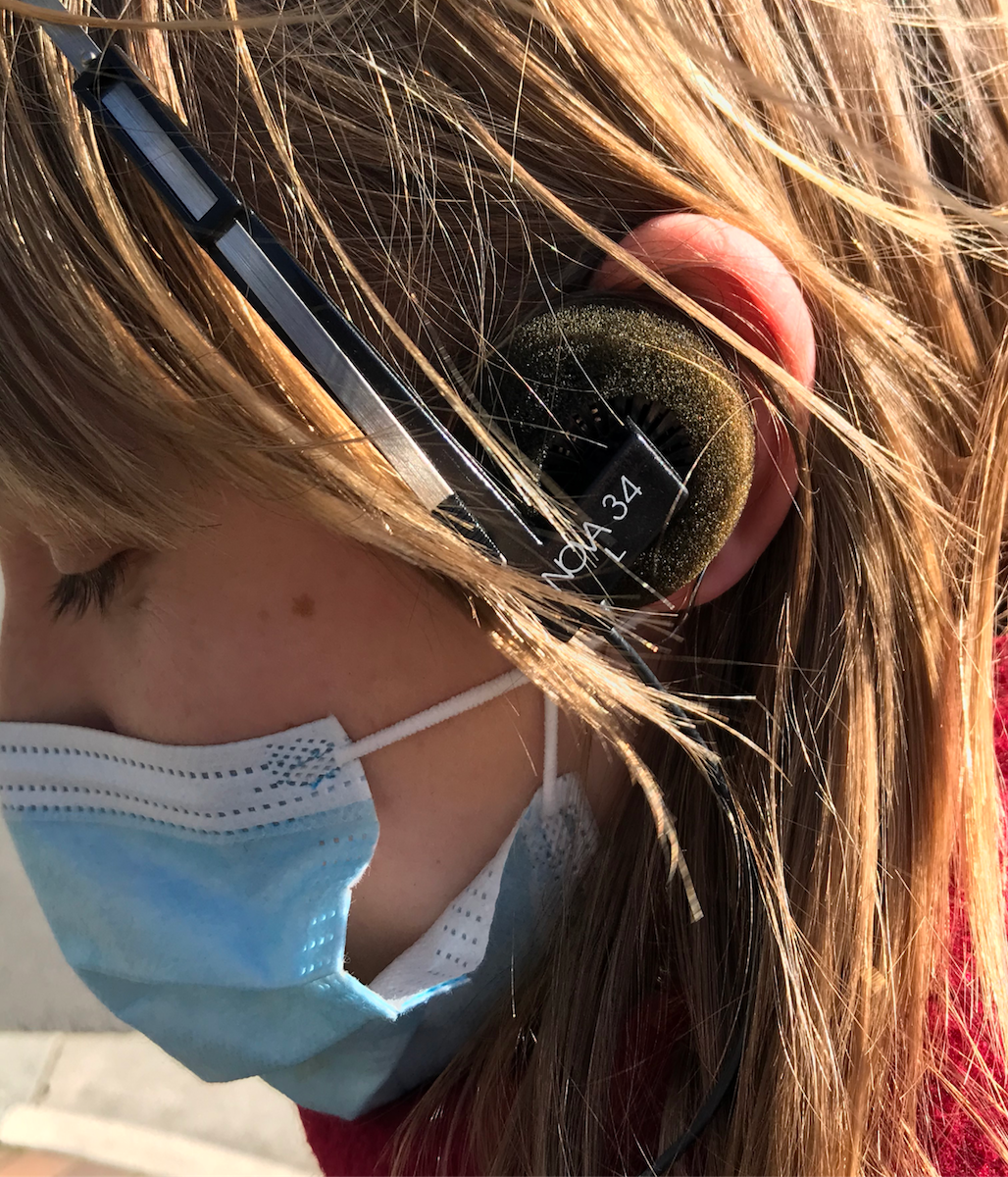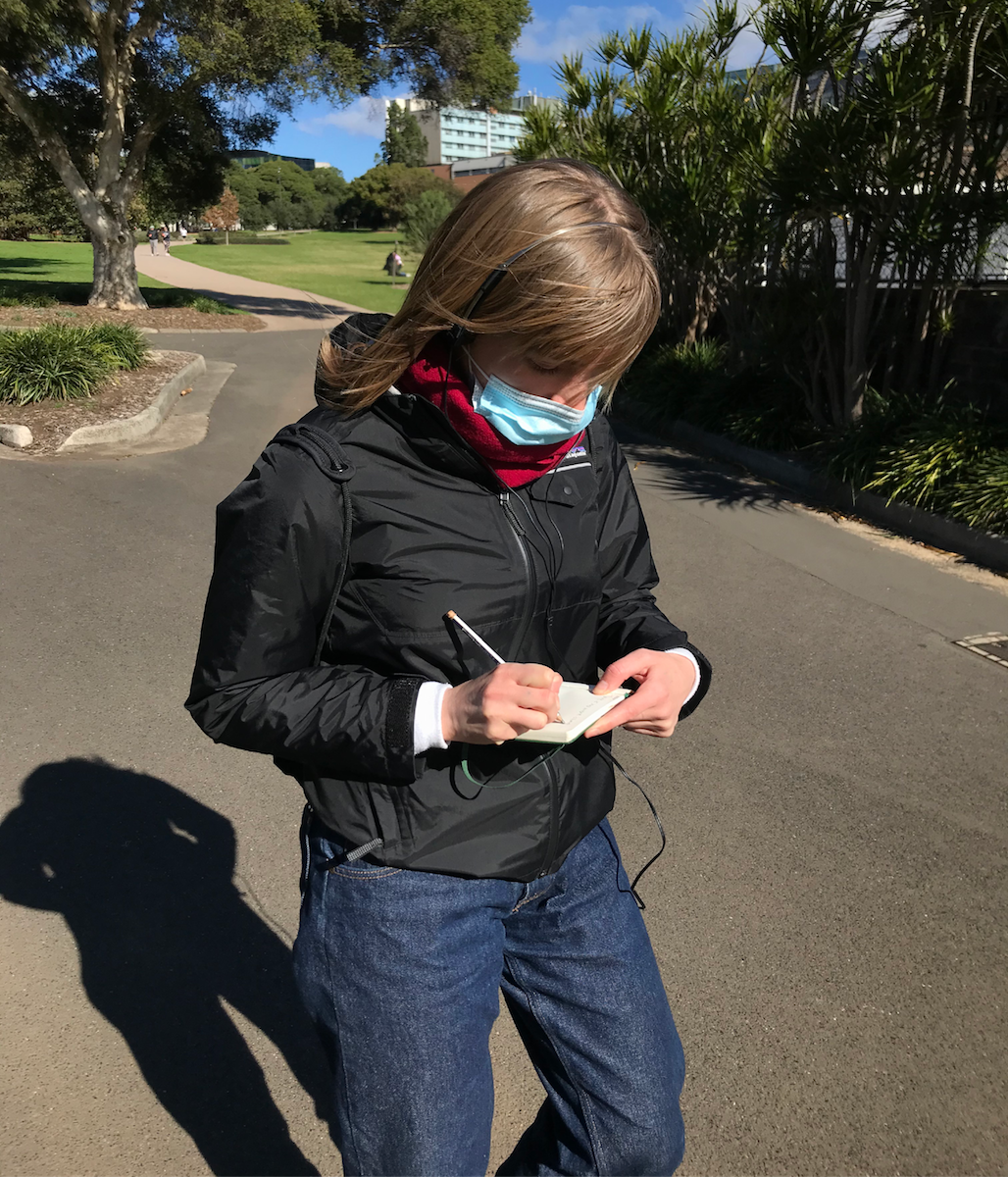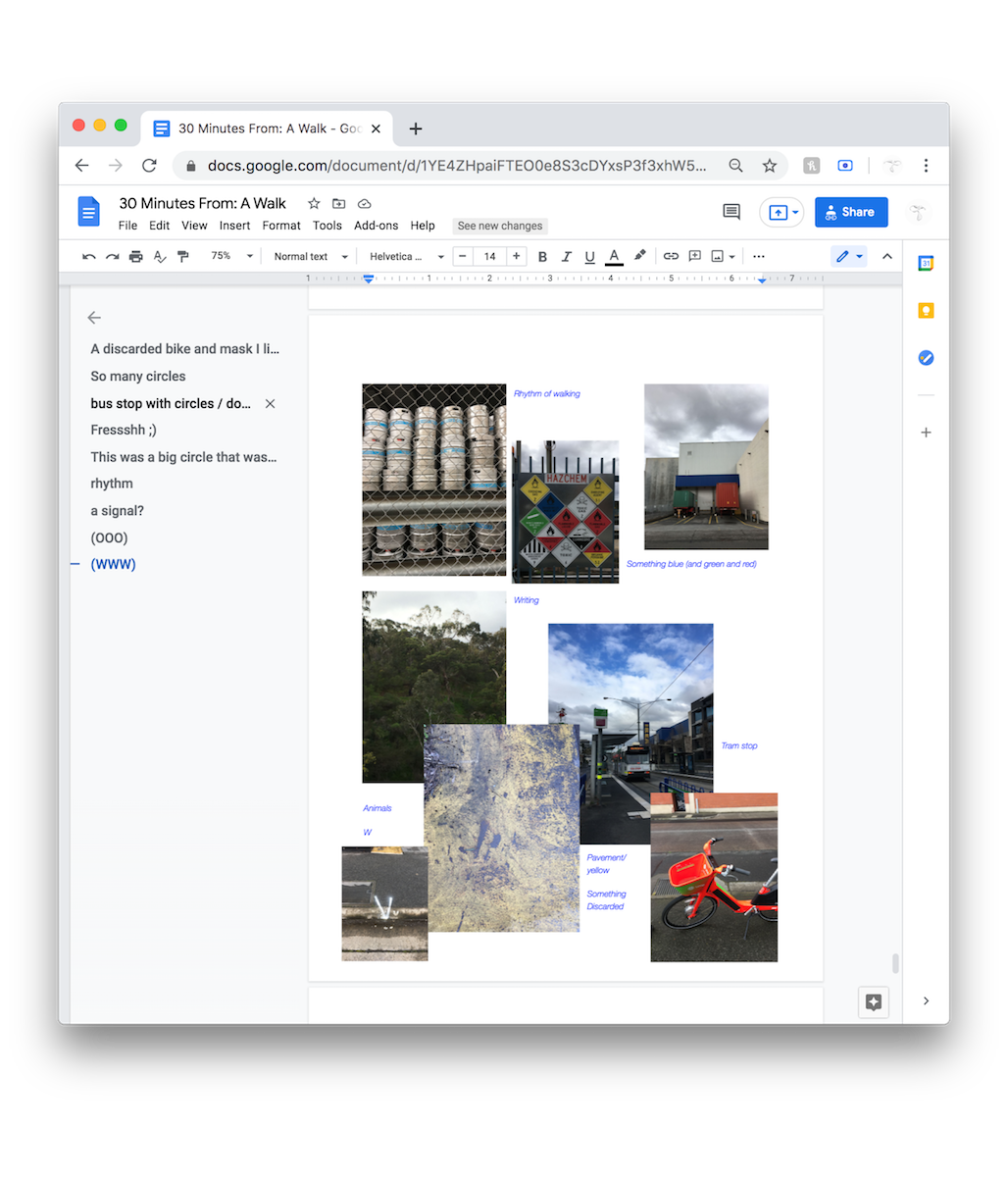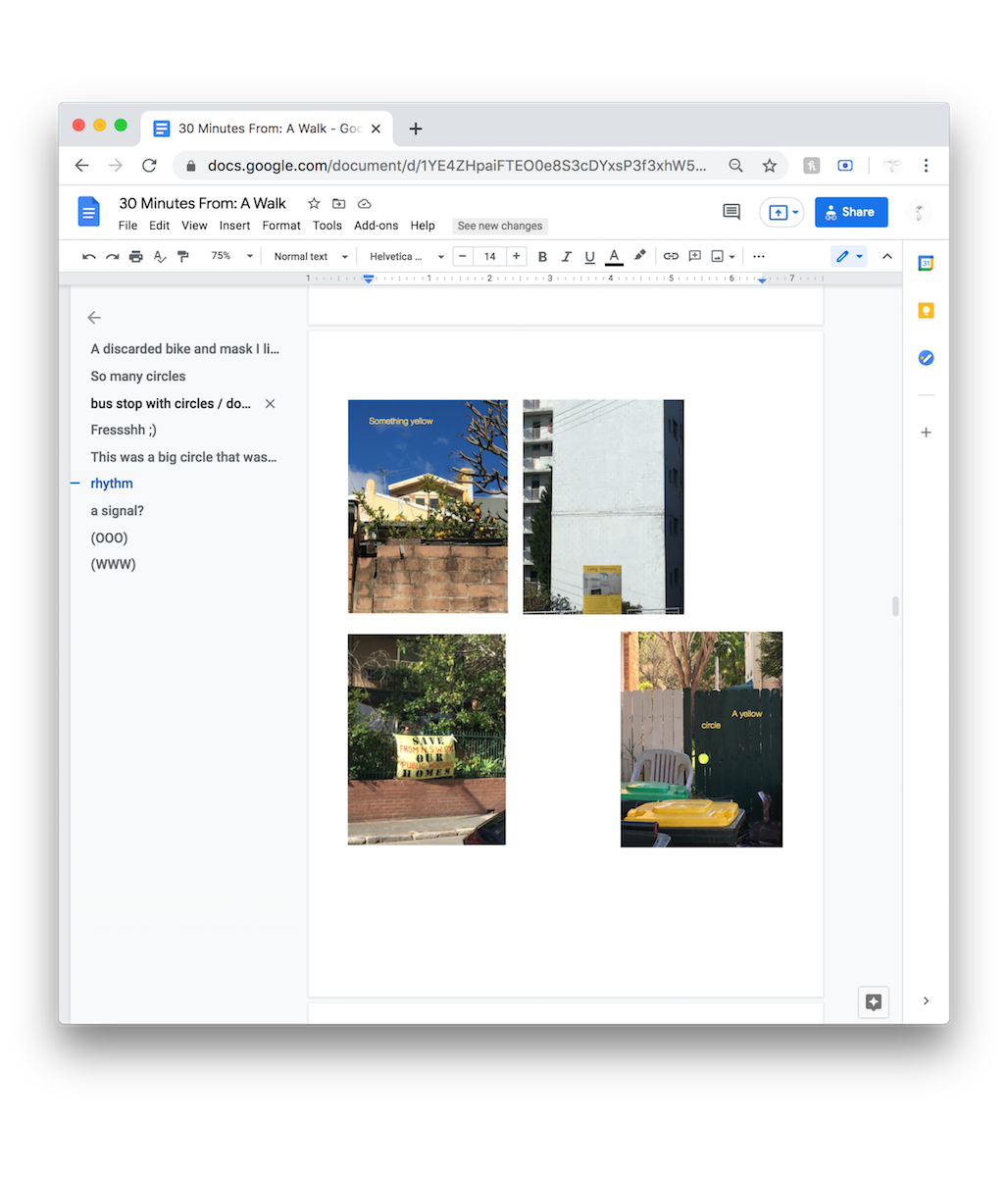Temporary Position Collaboration - 30 Minutes From: A Walk, 2021
Fascilitated by Temporary Position, I curated a collaborative walking guide to engage the public with their surroundings and each other. The event was interrupted by Sydney’s 2021 lockdown due to the Covid-19 pandemic. In this context, the audio guide and the shared Google doc became a way of sharing time with others when physical proximity was discouraged. We walked together but seperate through our locked-down landscape, connected by the same voice in our headphones. It gave an opportunity to escape our isolation for 30 minutes.
I encourage you to participate wherever you are and whenever you find the time. This is an ongoing happening open to all.
Audio guide accessed here.
Photo Prompts:
You can interpret these prompts however you like, take as
many or as little photos as you like or ignore it all together.
No former photographic experience is required.
![]()
Shared doc:
Once you’ve gathered your thoughts we invite you to share
them here (anonymous or not).
This is a place to gather, reflect, and improvise upon your
own and each others experiences.
Transcript: 30 Minutes From: A Walk – Marianna Ebersoll
Welcome
to 30 Minutes From: A Walk. I’m
Marianna Ebersoll and we’ll be walking together today. We begin now by taking
our first step. Here with this first step, I would like to acknowledge the
traditional owners and custodians of the land on which I’m walking, the Gadigal
people of the Eora nation and pay my respects to elders past and present. I’d
like to extend that respect to the traditional owners of the land on which you
are walking. I also recognise the practice of walking has been significant on
this land for thousands of years before me and is still alive and exists today.
This was and always will be, Aboriginal land.
Today
I guide you along your path towards our meeting point. You may have a companion
with you, acknowledge there is space between you, your walking rhythms are
their own. Look at each other knowing you are listening to the same words, this
is your secret. You may be alone; your legs walking underneath you supporting
your weight and creating their own rhythm. Today, we all are walking as
individuals, as we do everyday. What’s funny about today is that maybe, a few
streets away, maybe even on this street, there is someone else with a set of
headphones listening to these same words, walking as well, towards our meeting point.
In that thought, there is comfort.
Breathe
in now. Allow yourself to enjoy this space where nothing is asked of you but to
walk and look, feel how your body moves. My words don’t have to stick. Anything
is allowed in this space. We have 30 minutes. We can take our time.
There
is no right path here, the path you’re walking right now is good. That goes for
the photo prompt list with you as well. You can interpret these prompts however
you like, take as many or as little photos as you like or ignore it all
together, no former photographic experience is required. I’ll read the ten
prompts out now so that you can start searching:
- Something circular.
- A bus stop or train station.
- Something blue.
- The footpath.
- Something discarded.
- Writing that is within or on
or off the landscape.
- A composition that forms the
letter ‘W’.
- An animal.
- Something yellow.
- Something that has the
feeling or rhythm of walking.
Let
yourself observe things that aren’t necessarily interesting, maybe if you’re
lucky, something interesting will happen.
I’ll
be talking about my own journey as a walker and will also delve into the
history of walking. I’ll be talking about the radical act of walking, how it
can incite change and become a seditious act. I’ll be talking about how in
these days of lockdown and distance, walking has become a way of coming
together, to share and take in the changing world around us. I’ll be touching
on some writings that contextualise, inform and hopefully inspire us today as
we walk. I’ll also be playing some fitting music along the way. And for our
first song, we have These Boots are Made for Walking covered by The Boys Next
Door.
These Boots are Made for
Walking – The Boys Next Door
I’ve
been walking since I was 1. As a kid growing up between Sydney and the Blue
Mountains I did a lot of walking. I’ve walked up the mountain in front of my
dad’s veranda since I was in my mother’s stomach. Henry David Thoreau writes in
his 1862 essay Walking “though for so many years I have walked
almost every day … I have not yet exhausted them.” I’ve walked this mountain
every year probably. It never ceases to amaze me. If you’re walking a familiar
path today, allow it to show you something new. Often commutes that are walked
every day have the most beautiful changing scenery. What has changed since the
last time you walked this way?
In
high school, I would sometimes walk rather than taking the express train home.
It would take me three hours to walk along the train line. The world opens
itself up slowly when you walk. It takes a while to let your surroundings in.
Small things to notice are: people’s gardens, the different textures of paths, old
trees, new trees, graffiti, the cars, the brickwork, the sky. Note these down
in your iPhone notes, the best place for everything observed on the move.
However remember you’re allowed to pause and look. Imagine your walk as a dance
with the world, your movements changing as the landscape changes, sometimes
there’s reason to stop for a while.
While
you’re dancing, I will read a bit of the foreword of Georges Perec’s Species of Spaces first published in
1974. Perec was contracted to write this small book by an architect friend; he
delves into how we occupy urban and domestic space in his usual playful manner.
“…We
live in spaces, in these spaces, these towns, this countryside, these
corridors, these parks. That seems obvious to us. Perhaps indeed it should be
obvious. But it isn’t obvious, not just a matter of course. It’s real,
obviously, and as a consequence most likely rational. We can touch. We can even
allow ourselves to dream…
…spaces
have multiplied, been broken up and have diversified. There are spaces today of
every kind and every size, for every use and every function. To live is to pass
from one space to another, while doing your very best not to bump yourself.”
Walk on By – Dionne Warwick
I’d
like you to now think of the hundreds of different ways you’ve walked before
this, and I’d like you to wonder if and how this one is different today? Now think
of the hundreds of different ways people across the world have walked before
this, and I’d also like you to wonder if and how this one is different today?
We’ll put today’s walk in context now, reflecting on the various ways of
thinking about walking as a political, artistic, philosophical and religious
practice.
Early
forms of practiced walking are pilgrimages. These have been performed across a
myriad of faiths for thousands of years and are still practiced today. Often pilgrims
travelled to unknown places, this is reflected in the etymology of pilgrim from
Latin, peregrinus meaning ‘stranger’.
Strangers performing the same ritual, walking towards the same goal. The aim of
a pilgrimage was to search for new or expanded meaning about the pilgrim’s
self, about nature, or a higher good. They can last several years, months,
weeks, days or maybe even 30 minutes right now. What happens to this walk if it
becomes a pilgrimage? Can it?
Next
up comes the 19th century ‘flâneur’.
The flâneur was born in the Parisian
streets, usually a male figure that leisurely strolled, an observer of the
urban space, losing himself amidst the crowds. It’s important to recognise how
class and privilege change the experience of walking. These figures were often
wealthy enough to have the time and money to wander the streets at will, and
were men with the privilege to do as they pleased. There have been many
critiques of the flâneur phenomenon. I
will touch on one as I find it interesting for today’s practice. Helen Scalway,
a writer and artist, argues that the invariably masculine outlook of the flâneur sees the city as something
feminine, passive, there to be taken and conquered. She encourages a way of
traversing the city’s landscape as ‘a citizen’, negotiating and reacting with
regard for things that are ‘other’ than us. Today we are walking with the city, we are parts of its diverse character, not separate. When we observe,
observe with gentle understanding and openness. How does that change the way
you walk?
Walking
into the 20th century, the flâneur concept gave birth to the Dadaist’s ‘visits’and ‘events’, the Surrealist’s ‘deamublations’, the Lettrist’s and
Situationist’s ‘dérive’ and ‘situations’.
‘Visits’… ‘events’… ‘deamublations’
… ‘dérive’… ‘situations’.
These
terms span different groups and their various manifestos, all looking to the
city as a site for liberatory practices. The surrealists believed that urban
space could be crossed like your mind. Their deambulations tried to create a
sense of disorientation, intending to push boundaries between waking and
dreaming. Here is a good time to look at your photo list, there are some
prompts that encourage dreaming.
We
may be walking towards a set point but allow yourself to drift here.
The
‘dérive’ meaning drift, came about
with the Lettrists and Situationists. The ‘dérive’ was a collective act similar to deamublations. By drifting through the city,
the psychic effects of urban contexts were explored. It was seen as an artwork
that, when performed in a group had the power to break capitalist traditions of
owning and exchanging physical artforms. I’m drawn to this idea of the walk
becoming an artwork that belonged to the people walking, leaving no commercial
or consumable trace. This walking artform can arise with just you and your
surroundings. It is both playful and revolutionary and has paved the way for
modern artists exhausted by the commodification of art. They were optimistic in
their writings, stating “the new beauty will be that of the situation,
temporary and experienced” which would
“liberate the tendency towards play in everyday life.” Let yourself
playfully walk.
I’m
not saying things that haven’t been said before. This is an opportunity to
breathe in these musings and breathe in ourselves in our current environment.
This is the offering of a moment that is already yours but is also so many
other’s too. And in that, there is so much.
How
are we feeling? What have you seen thus far?
Let’s
now expand that idea of walking being revolutionary. I’d like to start by
reading an excerpt from Nadine Monem’s essay written for Melbourne Design Week,
“Walking as a subversive act”.
“In thinking about the
subversive act of walking, it is crucial to keep in mind that for many people,
moving through the city is always already subversive simply because of their
embodied experience of physical and political space.”
Power
relations are ever present as one walks, enforced by legal and social
structures. Because of physical ability or political freedom, walking is not
always readily available to everyone. People of colour, whether born in the
city, newly arrived or part of groups whose ancestral homes have been displaced
by colonial forces have also had their presence in public spaces criminalised
or met with harassment. Women have long had to avoid walking, especially at
night for their own safety. Cities that are increasingly designed for motorists
rather than walkers also overlook differently abled people, denying their
freedom to travel.
Walking
also provides an opportunity to rebel against the capitalist obsession with
productivity and time management. This kind of walking, of ambling is not
productive under any monetary scheme, it’s essentially ‘useless’. Enjoy this
uselessness. Allow the pressure to produce slide of your shoulders and walk
slow. This is not the fastest way to get from A to B. We are not rushing, we
are consciously and actively taking our time. Reclaiming time for ourselves
because time belongs to the individual. If you want to, find a spot to sit and
stop, now is a good time.
Here
I will offer some exercises written by Georges Perec in his chapter ‘The Street’ beginning at chapter three
titled Practical Exercises. Feel free
to follow, to drift in and out of, to sit with for a while, to tune out. We
begin:
“Observe the street, from
time to time, with some concern for system perhaps.
Apply yourself. Take your
time.
Note down the place: the
terrace of a café near the junction
the Rue de Bac and the
Boulevard
Saint-Germain
The time: seven o’clock in
the evening
The date: 15 May 1973
The weather: set fair
Note down what you can see.
Anything worthy of note going on. Do you know how to see what’s worthy of note?
Is there anything that strikes you?
Nothing strikes you. You
don’t know how to see.
You must set about it more
slowly, almost stupidly. Force yourself to write down what is of no interest,
what is most obvious, most common, most colourless.
The street: try to describe
the street, what it’s made of, what it’s used for. The people in the street.
The cars. What sort of cars? The buildings: note that they’re in the
comfortable, well-heeled side. Distinguish residential from official buildings.
The shops. What do they sell
in the shops? There are no food shops. Oh yes, there’s a baker’s. Ask yourself
where the locals do their shopping.
The cafés. How many cafes
are there? One, two, three, four. Why did you choose this one? Because you know
it, because it’s in the sun, because it sells cigarettes. The other shops:
antique shops, clothes, hi-fi, etc. Don’t say, don’t write ‘etc.’. Make an
effort to exhaust the subject, even if that seems grotesque, or pointless, or
stupid. You still haven’t looked at anything, you’ve merely picked out what
you’ve long ago picked out.
Force yourself to see more
flatly.
Detect a rhythm: the passing
of cars. The cars arrive in clumps because they’ve been stopped by a red light
further up or down the street.
Count the cars.
Look at the number plates.
Distinguish between the cars registered in Paris and the rest.
Note the absence of taxis
precisely when there seem to be a lot of people waiting for them.
Read what’s written in the
street: Morris columns, newspaper kiosks, posters, traffic signs, graffiti,
discarded handouts, shop signs.
Decipher a bit of the town,
deduce the obvious facts: the obsession with ownership, for example.
…
The people in the streets:
where are they coming from? Where are they going to? Who are they?
People in a hurry. People
going slowly. Parcels. Prudent people who’ve taken their macs. Dogs: they’re
the only animals to be seen. You can’t see any birds – yet you know there are
birds – and can’t hear them either. You might see a cat slip underneath a car,
but it doesn’t happen.
Nothing is happening, in
fact.
Try to classify the people:
those who live locally and those who don’t live locally. There don’t seem to be
any tourists. The season doesn’t lend itself to it, and anyway the area isn’t
especially touristy. What are the local attractions?
Time passes. Drink your
beer. Wait.
Note that the trees are a
long way off, that there are no cinemas or theatres, that there are no building
sites to be seen, that most of the houses seem to have obeyed the regulations
so far as renovation is concerned.
A dog, of an uncommon breed
(Afghan hound? Saluki?).
A Land Rover that seems to
be equipped for crossing the Sahara (in spite of yourself, you’re only noting
the untoward, the peculiar, the wretched exceptions; the opposite is what you
should be doing).
Carry on
Until the scene becomes
improbable
Until you have the
impression, for the briefest of moments, that you are in a strange town or,
better still, until you can no longer understand what is happening or is not
happening, until the whole place becomes strange, and you no longer even know
that this is what is called a town, a street, buildings, pavements…
Make torrential rain fall,
smash everything, make grass grow, replace the people by cows and, where the
Rue de Bac meets the Boulevard Saint-Germain, make King Kong appear, or Tex
Avery’s herculean mouse, towering a hundred metres above the roofs of the
buildings!
Or again: strive to picture
to yourself, with the greatest possible precision, beneath the network of
streets, the tangle of sewers, the lines of the Metro, the invisible
underground proliferation of conduits (electricity, gas, telephone lines, water
mains, express letter tubes), without which no life would be possible on the
surface.
Underneath, just underneath,
resuscitate the Eocene: the limestone, the marl and the soft chalk, the gypsum,
the lacustrian Saint-Ouen limestone, the Beauchamp sands, the rough limestone,
the Soissons sands and lignites, the plastic clay, the hard chalk.
Chapter 4: Or else: Rough
draft of a letter
I think of you, often.
Sometimes I go back into a
café, I sit near the door, I order a coffee
I arrange my packet of
cigarettes, a box of matches, a writing pad, my felt-pen on the fake marble
table
I spend a long time stirring
my cup of coffee with the teaspoon (yet I don’t put any sugar in my coffee, I
drink it allowing the sugar to melt in my mouth, like the people in the North,
like the Russians and Poles when they drink tea)
I pretend to be preoccupied,
to be reflecting, as if I had a decision to make
At the top and to the right
of the sheet of paper, I inscribe the date, sometimes the place, sometimes the
time, I pretend to be writing a letter
I write slowly, very slowly,
as slowly as I can, I trace, I draw each letter, each accent I check the
punctuation marks
I stare attentively at a
small notice, the price-list for ice-creams, at a piece of ironwork, a blind,
the hexagonal yellow ashtray (in actual fact, it’s an equilateral triangle, in
the cutoff corners of which semi-circular dents have been made where cigarettes
can be rested)
(…)
Outside there’s a bit of
sunlight
The café is nearly empty
Two renovators’ men are
having a rum at the bar, the owner is dozing behind his till, the waitress is
cleaning the coffee machine
I am thinking of you
You are walking in your street,
it’s wintertime, you’ve turned up your foxfur collar, you’re smiling, and
remote
(…)”
If
you’ve been sitting, allow yourself to start to move now.
We
are currently at the mercy of restrictions and lockdowns that inhibit movement
due to the Covid-19 pandemic. Our increased inside-ness has forced us out into
the streets and parks for limited times only. Often the only way to see others
is to go for a walk as an excuse for exercise. Going on tinder dates during
lockdown meant going for a walk together and gaging whether you could call them
a ‘cherished one’ that would be allowed to stay with you for ‘compassionate
reasons’. New interest has arisen in our home suburbs, previously only places
of rest. Now the landscape of our suburbs are studied and familiarised, we
notice when the couch on the side of the road has moved, whether its been
replaced by milk crates, or if the neighbours have placed a new pot plant in
their front garden, we notice how it grows and subtracts. Thoreau describes his
joy upon noticing something for the first time, “a single farmhouse which I had
not seen before is sometimes as good as the dominions of the King of Dahomey”.
Let yourself notice the normal, and let it fill you with excitement. Let
yourself connect to the world and to those around you through being outside and
moving. Remember that walking is also dancing. And here’s Grace Jones to teach
us about dancing.
Walking in the Rain – Grace
Jones
I
was thinking about the term to ‘walk it off’ and what it meant to me. It brings
up ideas of burly men telling other burly men to leave without rising to
aggression. It also brings up ideas of leaving a situation of discomfort for
the release of the outside. Today we’re walking it all off, letting it all
subside, using the physical motion and rhythm to lull us into comfort and calm.
Something about this rhythm that our body does without thinking, falls into
step with the rhythm of turning ideas over in our mind. Allow thoughts to come
and go, stick if they must but not aggravate. Allow your thoughts to come to
your breath and to your feet touching the ground at all times. We’re walking it
all off here.
We’re
nearing the end of our walk so I’ll leave you with these ruminations. We have
been walking together but separate, there are others like you listening to the
same recording, walking close to you by now. There is closeness and connection
there, we’ve been walking in tandem without even noticing. Look at your photo
list, see what still needs to be found in the world around you. I promise you
there’s examples of all close at hand. Push yourselves to look. There’s no
right photo, you can interpret things however you see fit.
Again,
I haven’t said anything that hasn’t been said before, I’m only floating through
it all and am offering the simple but very good gift of time to walk. But
remember this gift is yours, it always has been. This is something you can
access every day to take in the every day.
This
has been 30 Minutes From: A Walk and
I thank you for joining me today. I’d like to thank Temporary Position for
hosting this happening. You can find a reading list for all references
mentioned on the Temporary Position website or in the PDF we sent you. I’ll
play a few walking tunes now if you would like to continue this dance. I wish
you good wanderings and wonderings.
This is How We Walk on the
Moon – Arthur Russell
I’d Like to Walk Around Your
Mind - Vashti Bunyan
Walk in the Park – Beach
House
I Walk the Line – Johnny
Cash
A Walk – Tycho
Walkin’ After Midnight –
Patsy Cline
You’ll Never Walk Alone –
Gerry and the Pacemakers
Bibliography :
Bassett,
Keith. “Walking as an Aesthetic Practice and a Critical Tool: Some
Psychogeographic Experiments. Journal of
Geography in Higher Education. (2004).
Bridie,
Sandra interviewed by Melody Ellis. Walking
in the Configuration of Infinity. Melbourne, Bus Projects, 2021.
Careri,
Francesco. Walkscapes: Walking as an
Aesthetic Practice. Barcelona: Editorial Gustavo Gili, 2002.
Careri,
Francesco. “Walking. A Subversive Design Act.” Lecture, Presented by Molonglo
for Melbourne Design Week, Melbourne, Australia, March 17, 2020.
Monem,
Nadine. Reading and Writing Place:
walking as a subversive act. Originally published for Melbourne Design
Week, 2020. http://www.nadinemonem.com.
Perec,
Georges. Species of Spaces and Other
Pieces. London: Penguin Books, 1997.
Scalway,
Helen. “The Contemporary Flaneuse: exploring strategies for the drifter in the
feminine mode.” Journal of
Psychogeography and Urban Research. (2002).
Thoreau,
Henry David. “Walking.” The Atlantic, 1862.
Published online https://www.theatlantic.com/magazine/archive/1862/06/walking/304674/.







